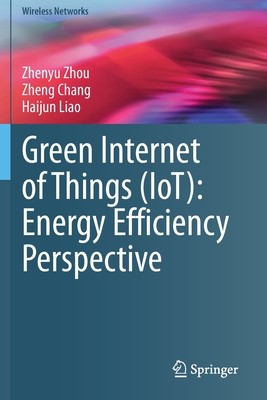
- We will send in 10–14 business days.
- Author: Zhenyu Zhou
- Publisher: Springer
- ISBN-10: 3030640566
- ISBN-13: 9783030640569
- Format: 15.6 x 23.4 x 1.1 cm, softcover
- Language: English
- SAVE -10% with code: EXTRA
Green Internet of Things (Iot): Energy Efficiency Perspective (e-book) (used book) | bookbook.eu
Reviews
Description
Preface
1 Introduction
2 Energy-Efficient Resource Allocationin for D2D Enabled Cellular
Networks
2.1 Energy-Efficient Resource Allocation Problem
2.1.1 System Model
2.1.2 Problem Formulation
2.2 Energy-Efficient Stable Matching for D2D Communications
2.2.1 Preference Establishment
2.2.2 Energy-Efficient Stable Matching
2.3 Performance Results and Discussions
3 Energy Harvesting Enabled Energy Efficient Cognitive
Machine-to-Machine Communications
3.1 Framework of Energy-Efficient Resource Allocation for
EH-Based CM2M
3.1.1 Data Transmission Model
3.1.2 Energy Harvesting and Energy Consumption Model
3.1.3 Energy Efficient Resource Allocation Problem
Formulation
3.2 Energy Efficient Joint Channel Selection, Peer Discovery, Power
Control and Time Allocation for EH-CM2M Communications
3.2.1 Matching Based Problem Transformation
3.2.2 First-Stage Joint Power Control and Time Allocation
Optimization
3.2.3 Preference List Construction
1
2 Contents
3.2.4 Second-Stage Joint Channel Selection and Peer
Discovery Based on Matching
3.3 Performance Results and Discussions
3.3.1 Improve Average Energy Efficiency of M2M-TXs
3.3.2 Improve Average Energy Efficiency of M2M Pairs.
4 Software Defined Machine-to-Machine Communication for SmartEnergy Management in Power Grids
4.1 Framework of Energy-Efficient SD-M2M for Smart Energy
Management
4.1.1 Architecture Overview
4.1.2 The Benefits of the SD-M2M
4.2 Software-Defined M2M Communication for Smart Energy
Management Applications
4.3 Case Study and Analysis
4.3.1 Improve Spectral Efficiency
4.3.2 Reduce the Total Energy Generation Cost.
5 Energy-Efficient M2M Communications in for Industrial
Automation
5.1 Framework of Energy-Efficient M2M Communications
5.2 Contract-Based Incentive Mechanism Design for Access Control
5.2.1 MTC Type Modeling
5.2.2 Contract Formulation
5.2.3 Contract Optimization
5.3 Resource Allocation Base on Lyapunov Optimization and
Matching Theory
5.3.1 Dynamic Queue Model5.3.2 Problem Formulation and Transformation
5.3.3 Joint Rate Control, Power Allocation and Channel
Selection
5.4 Performance Results and Discussions
5.4.1 Feasibility and Efficiency of Access Control Mechanism
5.4.2 Feasibility and Efficiency of Resource Allocation Scheme
6 Energy-Efficient Context-Aware Resource Allocation for
Edge-Computing-Empowered Industrial IoT
6.1 Framework of Energy-Efficient Edge-Computing-Empowered IIoT
6.1.1 System Model
6.1.2 Problem Formulation6.2 Learning-Based Context-Aware Channel Selection for the
Single-MTD Scenario
6.2.1 Lyapunov Based Problem Transformation
Contents
6.2.2 SEB-GSI Algorithm for the Ideal Case
6.2.3 SEB-UCB Algorithm for the Nonideal Case
6.3 Learing-Based Context-Aware Channel Selcetion for the
Multi-MTD Scenario
6.3.1 SEB-MGSI Algorithm for the Ideal Case
6.3.2 SEBC-MUCB Algorithm for the Nonideal Case
6.4 Performance Results and Discussions
6.4.1 Performance under the Single-MTD Scenario
6.4.2 Performance under the Multi-MTD Scenario
7 Licensed and Unlicensed Spectrum Management for Energ
EXTRA 10 % discount with code: EXTRA
The promotion ends in 20d.20:14:03
The discount code is valid when purchasing from 10 €. Discounts do not stack.
- Author: Zhenyu Zhou
- Publisher: Springer
- ISBN-10: 3030640566
- ISBN-13: 9783030640569
- Format: 15.6 x 23.4 x 1.1 cm, softcover
- Language: English English
Preface
1 Introduction
2 Energy-Efficient Resource Allocationin for D2D Enabled Cellular
Networks
2.1 Energy-Efficient Resource Allocation Problem
2.1.1 System Model
2.1.2 Problem Formulation
2.2 Energy-Efficient Stable Matching for D2D Communications
2.2.1 Preference Establishment
2.2.2 Energy-Efficient Stable Matching
2.3 Performance Results and Discussions
3 Energy Harvesting Enabled Energy Efficient Cognitive
Machine-to-Machine Communications
3.1 Framework of Energy-Efficient Resource Allocation for
EH-Based CM2M
3.1.1 Data Transmission Model
3.1.2 Energy Harvesting and Energy Consumption Model
3.1.3 Energy Efficient Resource Allocation Problem
Formulation
3.2 Energy Efficient Joint Channel Selection, Peer Discovery, Power
Control and Time Allocation for EH-CM2M Communications
3.2.1 Matching Based Problem Transformation
3.2.2 First-Stage Joint Power Control and Time Allocation
Optimization
3.2.3 Preference List Construction
1
2 Contents
3.2.4 Second-Stage Joint Channel Selection and Peer
Discovery Based on Matching
3.3 Performance Results and Discussions
3.3.1 Improve Average Energy Efficiency of M2M-TXs
3.3.2 Improve Average Energy Efficiency of M2M Pairs.
4 Software Defined Machine-to-Machine Communication for SmartEnergy Management in Power Grids
4.1 Framework of Energy-Efficient SD-M2M for Smart Energy
Management
4.1.1 Architecture Overview
4.1.2 The Benefits of the SD-M2M
4.2 Software-Defined M2M Communication for Smart Energy
Management Applications
4.3 Case Study and Analysis
4.3.1 Improve Spectral Efficiency
4.3.2 Reduce the Total Energy Generation Cost.
5 Energy-Efficient M2M Communications in for Industrial
Automation
5.1 Framework of Energy-Efficient M2M Communications
5.2 Contract-Based Incentive Mechanism Design for Access Control
5.2.1 MTC Type Modeling
5.2.2 Contract Formulation
5.2.3 Contract Optimization
5.3 Resource Allocation Base on Lyapunov Optimization and
Matching Theory
5.3.1 Dynamic Queue Model5.3.2 Problem Formulation and Transformation
5.3.3 Joint Rate Control, Power Allocation and Channel
Selection
5.4 Performance Results and Discussions
5.4.1 Feasibility and Efficiency of Access Control Mechanism
5.4.2 Feasibility and Efficiency of Resource Allocation Scheme
6 Energy-Efficient Context-Aware Resource Allocation for
Edge-Computing-Empowered Industrial IoT
6.1 Framework of Energy-Efficient Edge-Computing-Empowered IIoT
6.1.1 System Model
6.1.2 Problem Formulation6.2 Learning-Based Context-Aware Channel Selection for the
Single-MTD Scenario
6.2.1 Lyapunov Based Problem Transformation
Contents
6.2.2 SEB-GSI Algorithm for the Ideal Case
6.2.3 SEB-UCB Algorithm for the Nonideal Case
6.3 Learing-Based Context-Aware Channel Selcetion for the
Multi-MTD Scenario
6.3.1 SEB-MGSI Algorithm for the Ideal Case
6.3.2 SEBC-MUCB Algorithm for the Nonideal Case
6.4 Performance Results and Discussions
6.4.1 Performance under the Single-MTD Scenario
6.4.2 Performance under the Multi-MTD Scenario
7 Licensed and Unlicensed Spectrum Management for Energ


Reviews